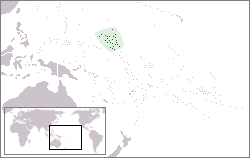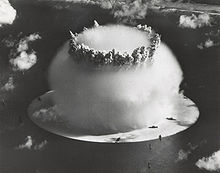Pacific Proving Grounds


The Pacific Proving Grounds was the name used to describe a number of sites in the Marshall Islands, in the Pacific Ocean, used by the United States to conduct nuclear testing at various times between 1946 and 1962. 67 atmospheric (i.e., not underground) nuclear tests were conducted there, many of which were of extremely high yield. While the Marshall Islands testing comprised only 14% of all U.S. tests, it comprised nearly 80% of the total yields of those detonated by the U.S., with an estimated total yield of 174 megatons, with the largest being the 15 Mt Castle Bravo shot of 1954 which spread considerable nuclear fallout on many of the islands.
Testing chronology
Operation Crossroads (1946)

The first use of the Pacific Proving Grounds was during Operation Crossroads, the first nuclear testing done after the atomic bombing of Hiroshima and Nagasaki. Two fission bombs, both with a yield of 21 kt, were detonated at the Bikini Atoll, one ("Able") from an altitude of 520 ft (158 m) on July 1, 1946, and another ("Baker") was detonated a depth of 90 ft (27 m) underwater on July 25. Both shots were detonated over old ships from World War II with the intent of learning the effects of atomic weapons on naval fleets. The Baker shot created a large condensation cloud and spread much more radioactive water onto the ships than was expected; many of the surviving ships were too "hot" to be used or decontaminated and had to eventually simply be sunk.
Operation Sandstone (1948)
Three weapons were detonated on the Enewetak Atoll as part of Operation Sandstone in 1948.
Operation Greenhouse (1951)
Four weapons were detonated on the Enewetak Atoll as part of Operation Greenhouse in 1951. Two are of particular note: Greenhouse "Item" was the first use of a boosted fission weapon, and "George" was a thermonuclear experiment designed to prove the feasibility of the Teller-Ulam design for the possibility of developing hydrogen bombs.
Operation Ivy (1952)
Two weapons were detonated at the Enewetak Atoll as part of Operation Ivy in 1952. One of them, Ivy King, was the largest pure-fission bomb ever detonated, with a yield of 500 kilotons, and the other, Ivy Mike, was the first hydrogen bomb device (it was too large to be an actual weapon), with a yield of 10.6 Mt.
Operation Castle (1954)

Six very large nuclear tests were conducted at the Bikini Atoll and the Enewetak Atoll as part of Operation Castle in 1954. The most notable was Castle Bravo, which was the first deployable (dry fuel) hydrogen bomb developed by the United States. Its yield, at 15 Mt was over twice as powerful as was predicted, and was the largest weapon ever detonated by the United States. It spread nuclear fallout over a wide area, including the Enewetak Atoll, Rongerik Atoll, Ailinginae Atoll, and Rongelap Atoll. An evacuation ensued, but many of the natives exposed suffered from cancers and a high incident of birth defects. A Japanese fishing boat, the Daigo Fukuryu Maru, was additionally exposed and resulted in one death from radiation sickness, which gained considerable international attention.
Operation Redwing (1956)
Seventeen nuclear weapons were detonated on the Bikini and Enewetak Atolls as part of Operation Redwing in 1956. Many of them were designed to prove the feasibility of numerous thermonuclear weapon designs, with yields ranging from around 2 to 5 Mt.
Operation Hardtack I (1958)
35 weapons were detonated at the Bikini Atoll, Enewetak Atoll, and Johnston Island as part of Operation Hardtack I in 1958.
Partial Test Ban Treaty (1963)
The signing of the Partial Test Ban Treaty in 1963 forbade atmospheric and underwater nuclear weapons, and so all further U.S. tests were conducted at the Nevada Test Site until the end of testing in 1992.
Remediation and compensation
Because of the large amount of atmospheric testing, and especially the Castle Bravo accident of 1954, many of the islands which were part of the Pacific Proving Grounds continue to be contiminated by nuclear fallout, and many of those who were living on the islands at the time of testing have suffered from increased incidence of various types of cancers and birth defects. The passing of the Radiation Exposure Compensation Act of 1990 allowed for a systematic filing of compensation claims in relation to testing as well as those employed at nuclear weapons facilities. Since 1956, at least $759 million USD has been paid to Marshall Islanders as compensation for their exposure to U.S. nuclear testing. $15.3 million was paid to Japan following the Castle Bravo accident.[1]
See also
External links
- "Gallery of U.S. Nuclear Tests" at Carey Sublette's NuclearWeaponArchive.org
- Bikini Atoll official website
- Republic of the Marshall Islands Nuclear Claims Tribunal
